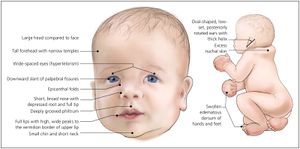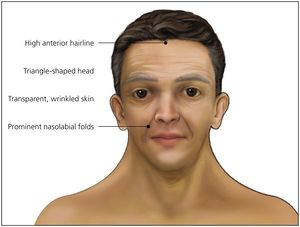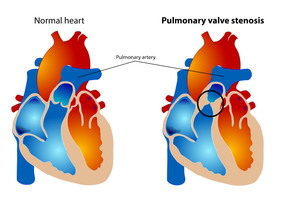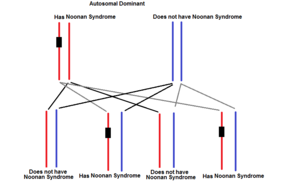Course:MEDG550/Student Activities/Noonan Syndrome
Noonan syndrome (NS) is a genetic condition characterized by mild facial features, short stature, heart defects, bleeding problems and skeletal malformations [1]. Notably, NS can result in delayed growth and development due to insufficient levels of growth hormone - puberty in males and females (less commonly) may be delayed. Developmental delay does not usually impact long-term intellectual ability into adulthood, but some children with NS may have severe intellectual disability requiring substantial learning support[1]. Though adults with NS have normal intelligence, they tend to have lower levels of education, less partnership and higher mortality than a typical adult[2]. It is estimated that 1 in 1000-2500 people have NS [3], and both males and females can be affected by this condition.
Clinical Features
NS is multisystemic, which means the condition affects several different parts of the body. Individuals with NS have recognizable features which includes:[4] [5][6]

Facial features
Differ with age and level of development; features are typically distinct at birth and childhood, and become subtler with age.
- Eyes: wide-set, downward slanting.
- Mouth: small lower jaw, prominent groove between the nose and upper lip.
- Ears: low-set, rotated back.
- Skin: thin, pale.
- Head: larger than average with a high, broad forehead.
- Neck: webbed, prominent

Growth and Development
- Birth weight: usually normal, but weight gain after birth is impeded.
- Eating difficulties: exacerbate poor weight gain, lead to inadequate nutrition intake.
- Insufficient growth hormone: delayed growth, especially in puberty, can lead to short stature into adulthood.
Learning
- Learning/Intellectual disability risk increased.
- Health, hearing and vision challenges are barriers to learning and understanding.
- Mild emotional, behavioural and mental issues.
Vision and Hearing
- Hearing loss both sensorineural (involving the nerves) and conductive (involving the structure of the inner ear).
- Nearsightedness (myopia) and farsightedness (hyperopia).
- Cataracts (clouding of the eye lens, leading to vision impairment).
Genital, Kidney differences
- Fertility is usually not impacted for females, but may be an issue for males with undescended testicles (cryptorchidism).
- Kidney differences are rare and most often mild.
- Puberty may be delayed in both males and females.
Other features
- Unusual chest shape (pectus extravatum, pectus carinatum)
- Widely shaped nipples
- Lymphatic malformations
- Varied bleeding defects
Congenital Heart Disease

Congenital heart disease (the presence of different types of heart defects) at birth is a common feature observed in NS individuals.
Pulmonary valve stenosis (the narrowing of the pulmonary heart valve) is the most common heart defect seen in NS, and is found in 20%-50% of individuals with NS. [7] The function of the pulmonary valve is to allow blood to flow out of the heart. When this heart valve narrows, individuals can develop a heart condition called Hypertrophic cardiomyopathy (thickened muscle in the heart), leading to complications. This is found in 20%-30% of individuals, and may be present at birth or develop in infancy or childhood. [8]
Other structural heart defects include Atrial and Ventricular Septal Defects (holes in the walls separating the heart chambers), Branch Pulmonary Artery Stenosis, and Tetralogy of Fallot (a group of four different heart defects). [5] If there is a major structural defect or blockage, heart surgery may be required.
Genetics of Noonan Syndrome
NS can be inherited, meaning it is a condition that can be passed down from parents to their children through their genes. Every individual has two copies of a particular gene, because we receive one each from our mother and father. Our genes are important for providing the instructions to make sure our body is undergoing proper growth and development. In NS individuals, they have mutations (errors in the genes) that prevent them from working properly, resulting in the features of NS.
Mutations have been found in several genes that can lead to NS. Majority of individuals with NS have mutations in the gene called PTPN11. Although less frequently, mutations in the following genes can also cause NS: SOS1, RAF1, KRAS, NRAS, BRAF, MAP2K1.
Genetic Counselling

The pattern in which NS is passed down is called autosomal dominant. This means that just one non-working copy of a gene that an individual inherits from either his/her mother or father is enough to cause NS. In a couple where one has NS and carries one working copy and one non-working copy of the gene, while the other partner carries two normal copies of the gene:
- There is a 50% chance that their future child will have NS (if the affected individual passes the bad copy)
- There is a 50% chance that their future child will be unaffected (if both passed down the normal copy)
Alternatively, the gene mutation is not inherited from the parents but is de novo, meaning it arose newly in the individual. In this scenario, both parents are unaffected, and the risk of having another affected child is less than 1%. Although many individuals with NS have a new mutation which occurs sporadically, there is an affected parent in 30%-75% of families. Genetic testing can help identify which gene is causing the condition in NS, and can also help identify whether the mutation was inherited or de novo. [9]
Diagnosing Noonan Syndrome
Making a diagnosis of NS in an individual relies on the observation of clinical features followed by confirmatory genetic testing. An individual with NS has a distinctive facial appearance that is most notable during infancy and childhood. This commonly includes: a large cranium (the part of the skull that encloses the brain), tall forehead, and downslanting eyes, and abnormal positioning of the ears. [3]
Genetic Testing
An individual with NS may sometimes be mistaken for other conditions such as, Leopard Syndrome, Neurofibromatosis Type 1, Costello Syndrome, and Cardiofaciocutaneous syndrome. This is because the genes that cause NS participate in the same biological pathway (RAS pathway) as the genes causing the other listed diseases. [10] It is important to perform genetic testing to see if the affected individual truly has NS, so that the appropriate treatment is offered.
A gene panel (which looks at several different genes at once) may be ordered when testing for NS, as more than one gene is known to cause the condition. A positive genetic testing result can confirm a NS clinical diagnosis. However, a negative result (meaning no mutation was found in the genes that were examined) does not rule out the possibility of NS. In fact, a small proportion of individuals with NS will have a negative result, as there are likely other genes that can cause NS but have not yet been discovered. [9]
Prenatal Diagnosis
Prenatal diagnosis can be considered in cases where the mutation in the specific gene is known in the family. This involves looking at the baby’s DNA to see if it carries the same change found in the affected parent. In addition, there are certain features that can be seen in an ultrasound that may raise the suspicion that a baby may be born with NS. [9]
Parents may want to consider being referred to a genetic counsellor if there is a known family history of NS. Genetic counsellors are trained health professionals that help parents decide which prenatal genetic test they are suitable for, and also provide more information about the condition. [11]
Management
There is currently no cure for NS. However, many symptoms as a result of the condition can be managed through surgery, medication, or other therapies and technologies. Provided that there are no severe heart abnormalities in individuals with NS, the life expectancy is expected to be in the normal range. As such, an early evaluation is important after a diagnosis of NS. [3]
Based on the known symptoms that occur in individuals with NS, a patient may be required to undergo the following examinations: [12] [3]
- Physical and neurological examination
- Weight and height measurements plotted on appropriate growth curve
- Cardiac evaluation by heart specialist, including electrocardiogram and echocardiogram
- Thyroid-function tests and antibodies if symptoms or hypothyroidism (lack of thyroid hormone) such as fatigue, constipation, poor growth
- Kidney ultrasound
- Brain and cervical spine MRI if presenting with neurologic signs
- Developmental screening
- Hearing evaluation
- Blood clotting tests
- Eye evaluation
- Complete blood count to assess for various blood disorders
- X-ray of spine and rib cage
Patient Resources
Noonan syndrome can be confused with Turner's syndrome and Fetal Alcohol Syndrome, as a result of similar clinical features overlapping with these conditions. This may cause families with an NS individual to feel unheard. It may be beneficial for NS individuals or parents with a recent child diagnosed with NS to join support groups and meet individuals living with the same condition.
The Noonan Syndrome Foundation
References
- ↑ 1.0 1.1 Genetics Home Reference, U.S. National Library of Medicine. Copyright National Institute of Health. Available at https://ghr.nlm.nih.gov/condition/noonan-syndrome. [Accessed February 1, 2018]
- ↑ Binder G, Grathwol S, von Loeper K, Blumenstock G, Kaulitz R, Freiberg C, Webel M, Lissewski C, Zenker M, Paul T. Health and quality of life in adults with Noonan syndrome. J Pediatr. 2012 Sep;161(3):501-505
- ↑ 3.0 3.1 3.2 3.3 Romano, A. A., Allanson, J. E., Dahlgren, J., Gelb, B. D., Hall, B., Pierpont, M. E., ... & Noonan, J. A. (2010). Noonan syndrome: clinical features, diagnosis, and management guidelines. Pediatrics, 126(4), 746-759.
- ↑ Online Mendelian Inheritance in Man, OMIM®. McKusick-Nathans Institute of Genetic Medicine, Johns Hopkins University (Baltimore, MD), {date}. World Wide Web URL: http://omim.org/
- ↑ 5.0 5.1 Roberts, A., et al., Noonan syndrome. Lancet, 2013. 381(9863): p. 333-342.
- ↑ The Mayo Clinic, Diseases & Conditions: Noonan Syndrome. Copyright 1998 - 2018. URL: https://www.mayoclinic.org/diseases-conditions/noonan-syndrome/symptoms-causes/syc-20354422 [Accessed on Feb 1, 2018]
- ↑ Bertola DR, Kim CA, Sugayama SM, et al. Cardiac Findings in 31 Patients with Noonan's Syndrome. Arq Bras Cardiol. 2000; 75(5): 409-23.
- ↑ Wilkinson JD, Lowe AM, Salbert BA, et al. Outcomes in children with Noonan syndrome and hypertrophic cardiomyopathy: a study from the Pediatric Cardiomyopathy Registry. Am Heart J. 2012;164:442–8.
- ↑ 9.0 9.1 9.2 GeneTests Medical Genetics Information Resource (database online). Copyright, University of Washington, Seattle. 1993-2013. Available at http://www.genetests.org. Accessed [March 6, 2013]
- ↑ Bitton, N., et al., Case report: Noonan-like multiple central giant cell granuloma syndrome. Pediatric dentistry, 2012. 34(5): p. 144-147.
- ↑ National Society of Genetic Counselors : Who are Genetic Counselors?. Nsgc.org (2017). at <http://www.nsgc.org/page/whoaregcs>
- ↑ Allanson, J.E. (2007). Noonan Syndrome. American Journal of Medical Genetics, 145C, 274-279. DOI: 10.1002/ajmg.c.30138